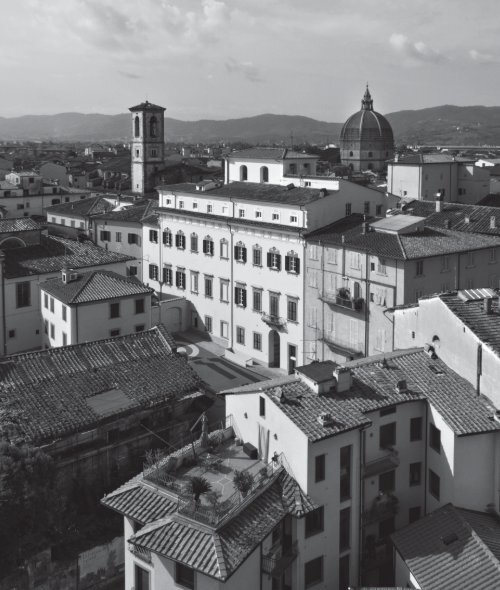Palazzo de'Rossi. Una storia pistoiese
a cura di Roberto Cadonici fotografie di Aurelio Amendola
a cura di Roberto Cadonici
fotografie di Aurelio Amendola
You also want an ePaper? Increase the reach of your titles
YUMPU automatically turns print PDFs into web optimized ePapers that Google loves.
UN PALAZZO NELLA CITTÀ<br />
LA NOBILE DIMORA DEI ROSSI E LE SUE VICENDE<br />
Lucia Gai<br />
L’importanza di un mito<br />
Costretta entro l’angusta prospettiva di una stretta via medioevale del centro di Pistoia,<br />
la facciata del settecentesco palazzo de’ Rossi 1 , impossibile da cogliere frontalmente e<br />
con un solo sguardo, pare un controsenso architettonico (figg. 1, 2).<br />
Sicuramente, almeno secondo i criteri con cui si sceglieva l’ubicazione delle residenze patrizie<br />
dal Quattrocento e per tutta l’età moderna, il palazzo non godeva di una posizione urbana<br />
particolarmente felice, non si affacciava su una piazza, su una via spaziosa, neppure su<br />
uno slargo che consentisse di apprezzarne, emergendo entro il fitto tessuto edilizio di una<br />
città d’impianto medioevale come Pistoia, l’articolazione strutturale, volumetrica e decorativa<br />
cui era affidato il compito di farsi metafora della fortuna e dell’importanza del casato.<br />
La posizione entro la città era infatti segno, di per sé, della ‘posizione’ sociale, dell’influenza<br />
e della ricchezza della famiglia. L’immagine, la percezione ottica stessa, nei secoli<br />
del “vedutismo”, si traduceva nell’opinione pubblica locale in capacità di permanente<br />
‘presenza’.<br />
Per la verità, Pistoia non offriva molte possibilità, in questo senso. Come aveva a riferire<br />
al granduca il commissario Giovan Battista Tedaldi nel 1570 2 , Pistoia non era città di<br />
piazze, di monumenti e fontane; non comprendeva quegli spazi aperti, quell’“agio” – consueto<br />
alla capitale di Toscana – che consentivano di fissare per sempre, nell’immaginario<br />
collettivo e nei ricordi dei protagonisti del turismo d’arte, città come Venezia, Firenze,<br />
Roma, Napoli e altre.<br />
Tuttavia, fra Sei e Settecento, a Pistoia i palazzi patrizi, come quelli dei Fabroni, dei Mar-<br />
A PALAZZO IN THE CITY<br />
THE NOBLE RESIDENCE OF THE ROSSI FAMILY AND ITS HISTORY<br />
Lucia Gai<br />
1. Pistoia, prospettiva dal Canto dei Rossi verso Via dei Rossi.<br />
The Importance of a Myth<br />
Squeezed into the cramped confines of a narrow medieval street in the center of Pistoia,<br />
the façade of the 18 th -century <strong>Palazzo</strong> de’ Rossi, 1 impossible to take in at a glance from<br />
the front, seems to be an architectural absurdity (figs. 1, 2).<br />
Certainly, at least according to the criteria by which the location of aristocratic residences<br />
was chosen from the 15th century onward and throughout the modern era, the building was<br />
not in a particularly happy position. It did not face onto a square, a broad street or any kind<br />
of open space that would make it possible to appreciate, amidst the dense urban fabric of a<br />
city with a medieval layout like Pistoia, the structural articulation, disposition of masses and<br />
decoration that were supposed to be an expression of the family’s wealth and importance.<br />
The position in the city was in fact a mark, in and of itself, of that family’s social “position,”<br />
of its influence and affluence. The image, the actual visual perception of the building,<br />
in the centuries of vedutismo, was translated in local public opinion into a capacity for<br />
permanent “presence.”<br />
To tell the truth, Pistoia did not offer many possibilities in this regard. As the<br />
commissioner Giovan Battista Tedaldi had told the grand duke in 1570, 2 Pistoia was not<br />
a city of squares, monuments and fountains; it did not have those open spaces, those<br />
“gaps”—customary in the capital of Tuscany—which fixed cities like Venice, Florence,<br />
Rome, Naples and others forever in the collective imagination and in the memories of<br />
tourists drawn by the cultural treasures of Italy.<br />
And yet, between the 17th and 18th century, the aristocratic residences of Pistoia, like<br />
2. Prospettiva della facciata del palazzo.<br />
30 31














